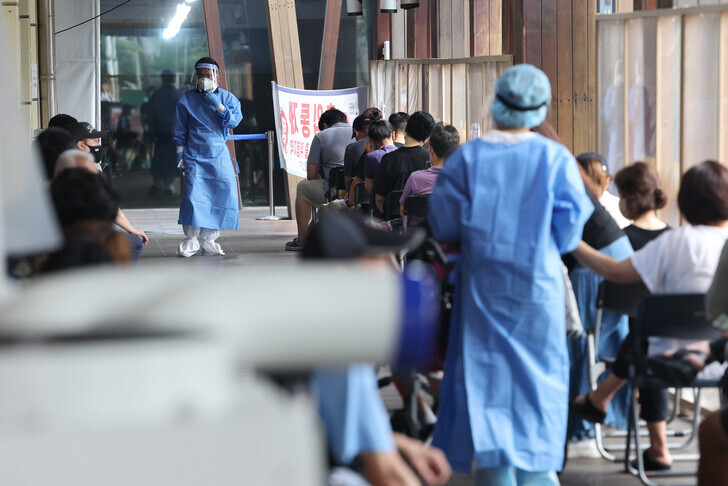hankyoreh
Links to other country sites 다른 나라 사이트 링크
Korea reports first case of “Centaurus” BA.2.75 subvariant, most transmissible known COVID-19 strain

South Korea has confirmed its first case of the BA.2.75 subvariant of the COVID-19 virus — nicknamed “Centaurus” — known to be the most transmissible out of all known COVID-19 variants and subvariants.
Especially of note, the positive case was reportedly a result of community transmission, which raises concerns that the coming COVID-19 wave in South Korea may be greater in size than what the government currently estimates.
The Korea Disease Control and Prevention Agency (KDCA) announced Thursday that it confirmed the first case of the BA.2.75 subvariant in South Korea. The individual who tested positive, who is in their 60s and lives in Incheon, showed symptoms on July 8 and had their COVID-19 diagnosis confirmed on Monday.
They did not travel domestically or internationally during the time they were likely infected, which means their infection was due to community transmission.
The individual is currently experiencing mild symptoms and is receiving at-home treatment. Additional positive cases have not surfaced yet among their four contacts, one of whom lives with them.
According to the KDCA’s explanation on the same day, the BA.2.75 subvariant was first identified in India on May 26 and has since resulted in 119 confirmed cases in 10 countries including the US, Canada, Germany, Australia and the UK.
According to research from Arkansas State University in the US, the BA.2.75 subvariant spread 3.24 times faster than the BA.5 variant in India in the last three months. The BA.5 variant has been known to spread 5 times faster than the original COVID-19 virus, but the BA.2.75 subvariant demonstrated even greater transmissibility.
Structurally, the BA.2.75 subvariant is more likely to cause breakthrough infections and reinfections. As it has more spike proteins than other subvariants, the BA.2.75 subvariant is able to more effectively penetrate host cells and evade antibodies formed through vaccination and infection.
The subvariant has been nicknamed the “Centaurus” subvariant after the therianthrope from Greek mythology based on its characteristics that diverge from the original COVID-19 virus.
On July 7, the World Health Organization classified the BA.2.75 subvariant as an Omicron subvariant “under monitoring,” meaning that the subvariant is highly likely to affect public health due to its high transmissibility or fatality rate.
Because the BA.2.75 subvariant is still early in its spread internationally, the rate at which it leads to serious and critical conditions or fatalities has not been determined. Experts point out that the fatality rate for BA.2.75 cases domestically and abroad should be monitored while testing should be expanded domestically so that additional infections from community spread do not occur.
Eom Joong-sik, a professor of infectious disease at Gachon University Gil Medical Center, commented, “While [the BA.2.75 subvariant] may be more transmissible than the BA.5 variant, as data concerning its fatality rate doesn’t exist, domestic and foreign data concerning its fatality rate should be closely monitored.” He added, “As the first suspected domestic case of the BA.2.75 subvariant resulted from community transmission, PCR testing should be expanded to discover hidden cases.”
The KDCA stated that it is “conducting contact tracing for those [who interacted with the positive case] within 14 days of final exposure and are conducting an in-depth investigation into the route of infection.” It continued, “As the BA.2.75 subvariant’s transmissibility is expected to increase, and immune escape seems possible, we will strengthen our observation efforts over domestic infections and foreign inflow and continue to closely monitor domestic infection trends.”
By Kwon Ji-dam, staff reporter; Jang Hyeon-eun, staff reporter
Please direct questions or comments to [english@hani.co.kr]

Editorial・opinion
![[Column] Season 2 of special prosecutor probe may be coming to Korea soon [Column] Season 2 of special prosecutor probe may be coming to Korea soon](https://flexible.img.hani.co.kr/flexible/normal/500/300/imgdb/original/2024/0426/3317141030699447.jpg) [Column] Season 2 of special prosecutor probe may be coming to Korea soon
[Column] Season 2 of special prosecutor probe may be coming to Korea soon![[Column] Park Geun-hye déjà vu in Yoon Suk-yeol [Column] Park Geun-hye déjà vu in Yoon Suk-yeol](https://flexible.img.hani.co.kr/flexible/normal/500/300/imgdb/original/2024/0424/651713945113788.jpg) [Column] Park Geun-hye déjà vu in Yoon Suk-yeol
[Column] Park Geun-hye déjà vu in Yoon Suk-yeol- [Editorial] New weight of N. Korea’s nuclear threats makes dialogue all the more urgent
- [Guest essay] The real reason Korea’s new right wants to dub Rhee a founding father
- [Column] ‘Choson’: Is it time we start referring to N. Korea in its own terms?
- [Editorial] Japan’s rewriting of history with Korea has gone too far
- [Column] The president’s questionable capacity for dialogue
- [Column] Are chaebol firms just pizza pies for families to divvy up as they please?
- [Column] Has Korea, too, crossed the Rubicon on China?
- [Correspondent’s column] In Japan’s alliance with US, echoes of its past alliances with UK
Most viewed articles
- 11 in 5 unwed Korean women want child-free life, study shows
- 2AI is catching up with humans at a ‘shocking’ rate
- 3[Editorial] Yoon cries wolf of political attacks amid criticism over Tokyo summit
- 4[Photo] “Comfort woman” survivor calls on president to fulfill promises
- 5“Japan’s No. 1 salesman”: Korean groups blast president’s treatment of forced laborers
- 6Yoon calls 60+ hour workweek “unreasonable,” orders revamp of policy
- 7[Editorial] Yoon’s white flag on historical disputes with Japan backfires immediately
- 8‘We must say no’: Seoul defense chief on Korean, USFK involvement in hypothetical Taiwan crisis
- 9[Special reportage- part I] Elderly prostitution at Jongmyo Park
- 10[Photo] More Sewol paintings by Hong Sung-dam